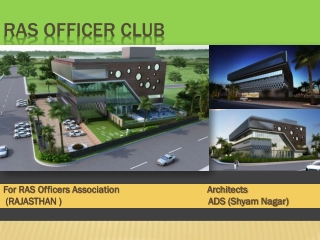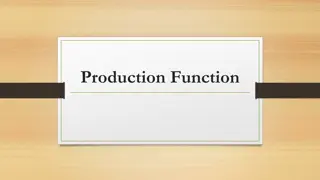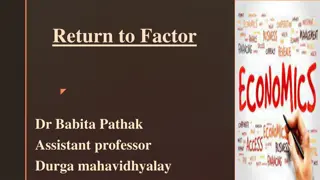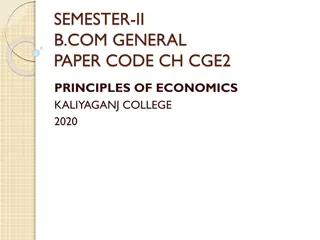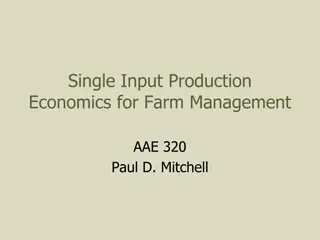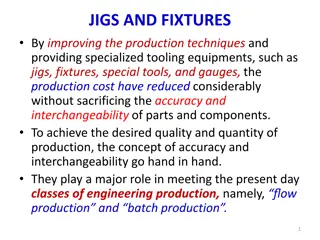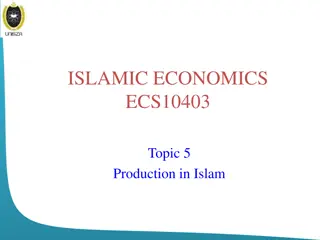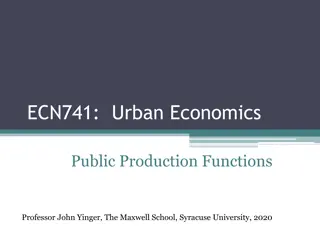
Boutique Farm Direct Market Study
Explore a boutique farm's direct market study focusing on production stages, study methods, results, and cost assumptions. Dive into the unique parameters of a small niche market targeting restaurants and consumers.
Download Presentation

Please find below an Image/Link to download the presentation.
The content on the website is provided AS IS for your information and personal use only. It may not be sold, licensed, or shared on other websites without obtaining consent from the author. If you encounter any issues during the download, it is possible that the publisher has removed the file from their server.
You are allowed to download the files provided on this website for personal or commercial use, subject to the condition that they are used lawfully. All files are the property of their respective owners.
The content on the website is provided AS IS for your information and personal use only. It may not be sold, licensed, or shared on other websites without obtaining consent from the author.
E N D
Presentation Transcript
Every situation is different Today s Example: Boutique sized farm (small niche market) Market Direct to Restaurants and Consumers Parameters HB Commercial RAS Demonstration results
Study Methods System: Water Temperature: Dissolved Oxygen: Alkalinity: Light / Dark: Salinity - egg to 5.5g: Salinity - 5.5g to 75g: Salinity - 75g to 680g: Low-Head RAS 27-30c 110 +/- 10% 200-250 mg/l 18h:6h > 28.0 ppt 12.0 +/- .05 ppt 8.0 +/- .05 ppt
Production Stages 1 Larval 2 Juvenile 3 Initial Growout 4 Final Growout Egg to 0.1g 0.1g to 5.5g 5.5g to 75g 75g to 680g (1 lbs)
Study Results Completed Stages Unit g g Days kg/m3 Stage 1 Stage 2 Stage 3 Total Initial Weight Harvest Weight Production Cycle Stocking Density 0 0.10 5.50 30 10 5.50 75 86 45 0.10 23 139 1 FCR Survival Rate Salinity 2.90 28% > 28 1.42 59% > 28 2.14 95% 12 15.7% ppt
Stage 4 - Incomplete Final Growout Results from prior USDA study Unit g g Days kg/m3 Stage 4 Total Initial Weight Harvest Weight Production Cycle Stocking Density 75 680 240 45 379 FCR Survival Rate Salinity 3.74 63% 9.9% ppt 8
Feed Types Stage 1 Otohime (A B2) Stage 2 Otohime (C1 S2) and Feed - 45% Protein Stage 3 & 4 Feed - 45% Protein
Baseline Assumptions: Use Harbor Branch demonstration tank systems Monthly Production 8,000 lbs whole fish (one 25 ft tank at 45 kg/M3 density) 11 HP consumed each hour 1.5 % System water loss per day
Cost Assumptions Feed Cost $32 for 50 lb bag for 45% protein (actual price, not bought in bulk) Egg Cost - $350 per 10,000 Manager Annual Salary - $60,000 Transfer / Harvest labor Full time farm staff 60 hours at $8 an Hour 2 at $10 an Hour
Direct Variable Cost per lb Stage 1 Stage 2 Stage 3 Stage 4 Total Eggs Feed 629.667 35.000 - - - 0.236 2.250 3.009 1.264 1.975 Oxygen - 0.065 0.009 0.089 0.001 0.139 0.002 0.156 0.002 Water 0.333 181.333 6.574 1.452 0.709 1.120 Electric Harvest Labor 0.114 0.040 0.060 3.824 Total Variable
Overhead Assumptions Overhead items included in the economic analysis Manager s Salary Hourly staff (non harvest) System Maintenance (estimated at 1% of equipment costs)
Overhead costs NOT included Chemicals Computers / Printers Phone System Copier Office Furniture Marketing expenses Website / Social Media Legal / Accounting Insurance Vehicles
Revenue Assumptions Price per lb whole fish $7.00 This is not a reasonable wholesale price, this assumes that a premium price is obtained by direct marketing
Boutique Financial Results without Capital Costs Annual Sales Less: Variable Costs 672,000 Eggs Feed 22,668 215,976 14,964 Oxygen Water Electric 180 107,520 5,760 367,068 Harvest Labor Gross Margin 304,932 Overhead Manager Staff 60,000 41,600 12,425 114,025 System Maintenance (1% Equip) Total Overhead Operating Income 190,907 96,000 Annual Production in lbs
Tanks and System Equipment Costs Stage 1: Stage 2: Stage 3: Stage 4: Approximate Cost 2 5 6 8 4 8 x 2 4 10 x 3 10 x 3 6 25 x 6 2,500 9,000 444,600 786,400 $1,242,500 Can Produce 96,000 lbs per year (whole fish) Approximate Square Feet Needed - 20,200
Equipment Capital Costs are Added Loan Assumptions: % Financing Interest Rate Equipment Term 75% 6% 10 Years Loan Principle 1st Year Interest Annual P&I Pymts 931,875 54,004 124,149
Boutique Financial Results with Equipment Costs Annual P& L Sales Less: 672,000 Total Variable Costs 367,068 304,932 Gross Margin Overhead Total Overhead 114,025 Operating Income 190,907 Non-Operating Expenses Interest Expense-Equip Depreciation-Equip 54,004 124,250 Total Non-Operating Expenses 178,254 Net Income 12,653 96,000 Annual Production in lbs
Location, Location, Location Assumption an existing warehouse will be purchased for our Boutique Farm Pricing based on properties available in this area (older property on the low end of the price scale) 21,000 sf Warehouse on .7 Acres $368,000 Purchase price:
Real Estate Costs are Added Loan Assumptions: % Financing Interest Rate Real Estate Term 75% 5% 20 Years Loan Principle 1st Year Interest Annual P&I Pymt 275,943 13,610 21,853
Boutique Financial Results Annual P& L Sales Less: 672,000 Total Variable Costs 367,068 Gross Margin 304,932 Overhead Total Overhead 114,025 Operating Income 190,907 Non-Operating Expenses Interest Expense-Equip Depreciation-Equip Interest Expense-Bldg Depreciation-Bldg 54,004 124,250 13,610 18,151 Total Non-Operating
But CASH is King Cash Flow - Annual from first Harvest Operating Income/Loss Less: Principle and Interest - Equip 190,907 124,149 66,758 Remaining Cash Principle and Interest - Bldg Remaining Cash 21,853 44,905
Start up Cash Down Payment Equipment Real Property 310,625 91,981 402,606 Working Capital 13 Months 315,000 717,606 Total
Conclusions Small Scale Producing Pompano Commercially in RAS has potential in a niche market if the sales price can be kept at $7 or above Could broaden offerings to customers, if you currently have a direct market customer base for other species
Conclusions Large Scale Profitability on a large scale with wholesale prices at $5.25 would be difficult without significant savings in feed and equipment costs as well as improvements in survival rates and FCRs We will look at some models which will demonstrate the challenges that remain for a large commercial venture using the results presented today

